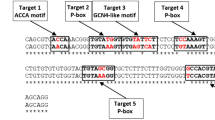Abstract.
The role of pyrophosphate:fructose-6-phosphate 1-phosphotransferase (PFP) in developing leaves was studied using wild-type tobacco (Nicotiana tabacum L.) and transformants with decreased expression of PFP. (i) The leaf base, which is the youngest and most actively growing area of the leaf, had 2.5-fold higher PFP activity than the leaf tip. T3 transformants, with a 56–95% decrease in PFP activity in the leaf base and an 87–97% decrease in PFP activity at the leaf tip, were obtained by selfing and re-selfing individuals from two independent transformant lines. (ii) Other enzyme activities also showed a gradient from the leaf base to the leaf tip. There was a decrease in PFK and an increase in fructose-6-phosphate,2-kinase and plastidic fructose-1,6-bisphosphatase, whereas cytosolic fructose-1,6-bisphosphatase activity was constant. None of these gradients was altered in the transformants. (iii) Fructose-2,6-bisphosphate (Fru2,6bisP) levels were similar at the base and tip of wild-type leaves in the dark. Illumination lead to a decrease in Fru2,6bisP at the leaf tip and an increase in Fru2,6bisP at the leaf base. Compared to wild-type plants, transformants with decreased expression of PFP had up to 2-fold higher Fru2,6bisP at the leaf tip in the dark, similar levels at the leaf tip in the light, 15-fold higher levels at the leaf base in the dark, and up to 4-fold higher levels at the leaf base in the light. (iv) To investigate metabolic fluxes, leaf discs were supplied with 14CO2 in the light or [14C]glucose in the light or the dark. Discs from the leaf tip had higher rates of photosynthesis than discs from the leaf base, whereas the rate of glucose uptake and metabolism was similar in both tissues. Significantly less label was incorporated into neutral sugars, and more into anionic compounds, cell wall and protein, and amino acids in discs from the leaf base. Metabolism of 14CO2 and [14C]glucose in transformants with low PFP was similar to that in wild-type plants, except that synthesis of neutral sugars from 14CO2 was slightly reduced in discs from the base of the leaf. (v) These results reveal that the role of PFP in the growing cells in the base of the leaf differs from that in mature leaf tissue. The increase in Fru2,6bisP in the light and the high activity of PFP relative to cytosolic fructose-1,6-bisphosphatase in the base of the leaf implicate PFP in the synthesis of sucrose in the light, as well as in glycolysis. The large increase in Fru2,6bisP at the base of the leaf of transformants implies that PFP plays a more important role in metabolism at the leaf base than in mature leaf tissue. Nevertheless, there were no major changes in carbon fluxes, or leaf or plant growth in transformants with below 10% of the wild-type PFP activity at the leaf base, implying that large changes in expression can be compensated by changes in Fru2,6bisP, even in growing tissues
Similar content being viewed by others
Author information
Authors and Affiliations
Additional information
Electronic Publication
Rights and permissions
About this article
Cite this article
Nielsen, T., Stitt, M. Tobacco transformants with strongly decreased expression of pyrophosphate:fructose-6-phosphate expression in the base of their young growing leaves contain much higher levels of fructose-2,6-bisphosphate but no major changes in fluxes. Planta 214, 106–116 (2001). https://doi.org/10.1007/s004250100591
Received:
Accepted:
Issue Date:
DOI: https://doi.org/10.1007/s004250100591




